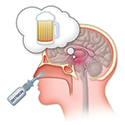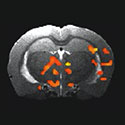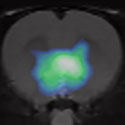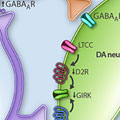Hot Off the Press – April 22, 2019. The neuropeptide oxytocin blocks enhanced drinking in alcohol-dependent rats, according to a study published April 16 in the open-access journal PLOS Biology led by Drs. Tunstall, Koob and Vendruscolo of the National Institutes of Health, and Drs. Kirson and Roberto of The Scripps Research Institute. Targeting the… [Read More]
News Main
Ultrapotent chemogenetics for research and potential clinical applications.
Hot Off the Press – April 12, 2019. NIDA-funded scientists have just published findings in the journal Science showing the development of a new, groundbreaking chemogenetics technology for modulating brain function in a remote, precise and ultra-sensitive manner in living subjects. These findings describe new chemogenetic ion channels for neuron activation and silencing that are controlled by… [Read More]
Heroin addiction engages negative emotional learning brain circuits in rats
Hot Off the Press – April 8, 2019. The United States is amid an unprecedented opioid epidemic. From 2002 through 2016, the number of heroin users increased by 135% and the number of deaths attributable to heroin increased by 533%. Therefore, there is an urgent need for research into the neurobiology of opioid use disorder… [Read More]
Dopamine D3R antagonist VK4-116 attenuates oxycodone self-administration and reinstatement without compromising its antinociceptive effects.
Featured Paper of the Month – April 2019
Published in Neuropsychopharmacology by You, Zhi-Bing; Bi, Guo-Hua; Galaj, Ewa; Kumar, Vivek; Cao, Jianjing; Gadiano, Alexandra; Rais, Rana; Slusher, Barbara S; Gardner, Eliot L; Xi, Zheng-Xiong; Newman, Amy Hauck
Opioid use disorders are currently a serious health problem worldwide and yet prescription opioids remain as the most effective medications to treat pain. VK4-116, a highly selective dopamine D3 receptor antagonist, significantly inhibited acquisition of oxycodone self-administration behaviors and decreased oxycodone seeking in several rodent models. VK4-116 was also effective in a model of opioid-induced relapse and on diminishing the aversive effects of naloxone precipitated withdrawal…
Opioid-galanin receptor heteromers mediate the dopaminergic effects of opioids
Hot Off the Press – April 1, 2019. Identifying non-addictive opioid medications is a high priority in medical sciences, but μ-opioid receptors mediate both the analgesic and addictive effects of opioids. We found a significant pharmacodynamic difference between morphine and methadone that is determined entirely by heteromerization of μ-opioid receptors with galanin Gal1 receptors, rendering… [Read More]
Synaptic and intrinsic plasticity in the ventral tegmental area after chronic cocaine.
Reviews To Read – March 2019. Cocaine drives persistent changes in synaptic transmission and ventral tegmental area dopamine neuron activity. Francis et al. reviews how these alterations contribute to cocaine addiction and highlight therapeutic avenues for future treatment.
Molecular Adaptations in the Rat Dorsal Striatum and Hippocampus Following Abstinence-Induced Incubation of Drug Seeking After Escalated Oxycodone Self-Administration.
Featured Paper of the Month – March 2019
Published in Molecular Neurobiology by Blackwood, Christopher A; Hoerle, Reece; Leary, Michael; Schroeder, Jennifer; Job, Martin O; McCoy, Michael T; Ladenheim, Bruce; Jayanthi, Subramaniam; Cadet, Jean Lud
Abuse of opioids including oxycodone is very prevalent in the US. Researchers in the laboratory of Jean Lud Cadet in the NIDA IRP have shown that when rats are given access to oxycodone for several hours, some of the rats will increase the amount of the drug in a very steep fashion whereas others will only take moderate quantities of the drug. They also found, however, that, after a month of withdrawal from oxycodone, all those rats had decreased levels of mu opioid receptor protein in the dorsal striatum, a brain region that is important for habit forming…
Marco Venniro receives the 2019 Young Investigator Award by the European Behavioral Pharmacology Society
The winner of the 2019 European Behavioral Pharmacology Society’s Young Investigator Award is Marco Venniro, Ph.d., for his research examining the influence of social cues on behaviors related to drug addiction which was recently published in Nature Neuroscience. Marco is a CCB Postdoctoral Fellow in the lab of Yavin Shaham, Ph.d. Prior to this award, Marco has also been the… [Read More]
Lorenzo Leggio given the ACNP Eva King-Killam Research Award
The American College of Neuropsychopharmacology (ACNP) has named Lorenzo Leggio, M.D., Ph.D. as the winner of the Eva King-Killam Research Award. Dr. Leggio is a Clinical Investigator and Section Chief for the NIAAA and NIDA Intramural Research Programs (IRPs). He also serves as Associate Director for Clinical Research for the NIDA IRP Medication Development Program…. [Read More]
Deletion of the type 2 metabotropic glutamate receptor increases heroin abuse vulnerability in transgenic rats.
Featured Paper of the Month – February 2019
Published in Neuropsychopharmacology by Gao, Jun-Tao; Jordan, Chloe J; Bi, Guo-Hua; He, Yi; Yang, Hong-Ju; Gardner, Eliot L; Xi, Zheng-Xiong
Despite extensive research in the past decades, little is known about the etiology of opioid addiction. In this study, Xi and colleagues found that genetic deletion of mGluR2, a glutamate receptor subtype, in rats caused an increase in brain dopamine responses to heroin and in opioid reward, facilitating the development of opioid use and abuse. This finding suggests that low-mGluR2 expression in the brain may be a risk factor for the development of opioid abuse and addiction…










